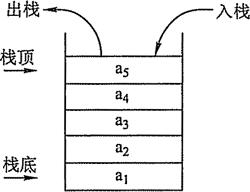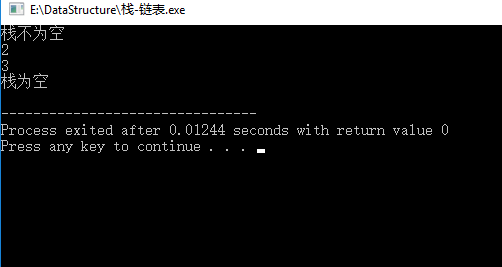引言
栈(stack)是一种被广泛使用的线性数据结构,它只允许在表的一端进行插入或删除操作,因而栈也可以被称作为操作受限的线性表 。在栈中,允许插入或删除的一端称作栈顶(top)不允许插入和删除的另一端称作栈底(bottom);
示意图如下:

此文借助单链表简单地实现栈及其基本操作。
代码如下:

typedef struct stack{ int data; struct stack* next; }ListStack;
注:这里假设栈中储存的是整型 (int) 的数据
基本操作
1.栈的初始化

void init(ListStack** top) { *top = NULL; }
2.进栈

void push(ListStack** top, int value) { ListStack * newNode = (ListStack*)malloc(sizeof(ListStack)); newNode->data = value; newNode->next = *top; *top = newNode; }
3.出栈

int pop(ListStack** top) { if(*top==NULL){ return NULL; }else{ ListStack* p = *top; int val = p->data; *top = (*top)->next; free(p); return val; } }
4.判断栈是否为空

bool isEmpty(ListStack** top) { if((*top)==NULL){ return true; }else{ return false; } }
5.清空栈

void clear(ListStack** top) { if((*top)!=NULL){ ListStack* pFree, * pExtra; pFree = *top; while(pFree!=NULL){ pExtra = pFree; pFree = pFree->next; free(pExtra); } *top = NULL; } }
进行测试 :

int main(void) { ListStack s; ListStack * top; init(&top); //入栈 push(&top, 3); push(&top, 2); if(isEmpty(&top)){ printf("栈为空 "); }else{ printf("栈不为空 "); } //出栈 printf("%d ", pop(&top)); printf("%d ", pop(&top)); push(&top, 333); push(&top, 666); clear(&top); if(isEmpty(&top)){ printf("栈为空 "); }else{ printf("栈不为空 "); } return 0; }
测试结果:

完整代码

#include<stdio.h> #include<stdlib.h> typedef struct stack{ int data; struct stack* next; }ListStack; void init(ListStack** top); void push(ListStack** top, int value); int pop(ListStack** top); bool isEmpty(ListStack** top); void clear(ListStack** top); int main(void) { ListStack s; ListStack * top; init(&top); //入栈 push(&top, 3); push(&top, 2); if(isEmpty(&top)){ printf("栈为空 "); }else{ printf("栈不为空 "); } //出栈 printf("%d ", pop(&top)); printf("%d ", pop(&top)); push(&top, 333); push(&top, 666); clear(&top); if(isEmpty(&top)){ printf("栈为空 "); }else{ printf("栈不为空 "); } return 0; } void init(ListStack** top) { *top = NULL; } void push(ListStack** top, int value) { ListStack * newNode = (ListStack*)malloc(sizeof(ListStack)); newNode->data = value; newNode->next = *top; *top = newNode; } int pop(ListStack** top) { if(*top==NULL){ return NULL; }else{ ListStack* p = *top; int val = p->data; *top = (*top)->next; free(p); return val; } } bool isEmpty(ListStack** top) { if((*top)==NULL){ return true; }else{ return false; } } void clear(ListStack** top) { if((*top)!=NULL){ ListStack* pFree, * pExtra; pFree = *top; while(pFree!=NULL){ pExtra = pFree; pFree = pFree->next; free(pExtra); } *top = NULL; } }
